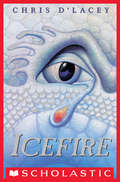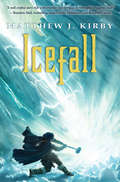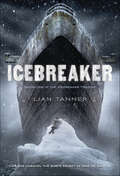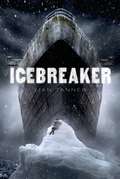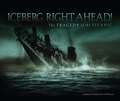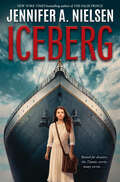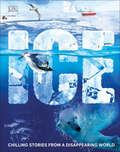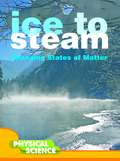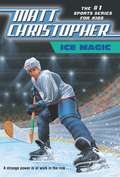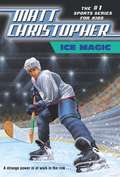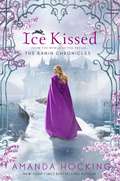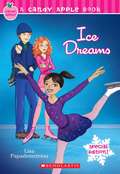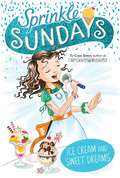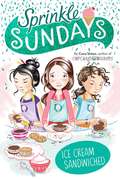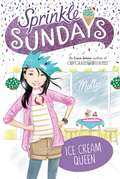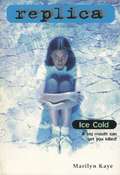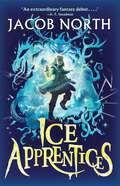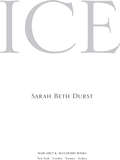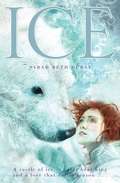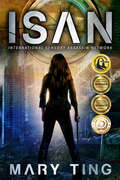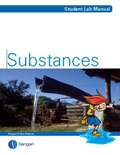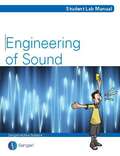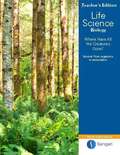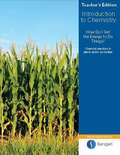- Table View
- List View
Icefire (The Last Dragon Chronicles #2)
by Chris d'LaceyThe second in a series from bestselling author Chris d'Lacey. Full of adventure and suspense, this novel about dragons reveals the truth of the icefire.When David is assigned an essay on the history of dragons, there is only one thing he knows for sure -- he wants to win the prize of a research trip to the Arctic.As David begins to dig deeper into the past, he finds himself drawn down a path from which there is no going back . . . to the very heart of the legend of dragons, and the mysterious, ancient secret of the icefire. . . .Don't miss Chris d'Lacey's addition to his rich dragon mythology in his next series, The Erth Dragons!
Icefall
by Matthew J. KirbyTrapped in a hidden fortress tucked between towering mountains and a frozen sea, Solveig, along with her brother the crown prince, their older sister, and an army of restless warriors, anxiously awaits news of her father's victory at battle. But as winter stretches on, and the unending ice refuses to break, terrible acts of treachery soon make it clear that a traitor lurks in their midst. A malevolent air begins to seep through the fortress walls, as a smothering claustrophobia slowly turns these prisoners of winter against one another.Those charged with protecting the king's children are all suspect, and the siblings must choose their allies wisely. But who can be trusted so far from their father's watchful eye? Can Solveig survive the long winter months and expose the traitor before he manages to destroy a kingdom?"A well-crafted story rich with emotion and intrigue. A thoroughly engaging read!" -- Brandon Mull, bestselling author of the Fablehaven and Beyonders series
Icebreaker: Book Three Of The Icebreaker Trilogy (The Icebreaker Trilogy #1)
by Lian TannerAn enthralling adventure set in a strange world on the high seas.Petrel is an outcast on the ancient ship, an icebreaker, that has been following the same course for 300 years. In that time, the ship's crew has forgotten its original purpose and broken into three warring tribes. Everyone has a tribe except Petrol. Nicknamed the Nothing Girl, Petrel has been ostracized ever since her parents were thrown overboard as punishment for a terrible crime. But Petrel is a survivor. She lives in the ship's darkest corners, and trusts no one except two large gray rats - that is, until a mysterious boy is discovered barely alive on an iceberg, and brought onto the ship. He claims to have forgotten even his name. The tribes don't trust strangers, so Petrel hides the boy, hoping he will be her friend. What she doesn't know is that the ship guards a secret - a secret the boy has been sent to destroy.
Icebreaker (The Icebreaker Trilogy #1)
by Lian Tanner<p>An enthralling adventure set in a strange world on the high seas. <p>Petrel is an outcast on the ancient ship, an icebreaker, that has been following the same course for 300 years. In that time, the ship's crew has forgotten its original purpose and broken into three warring tribes. Everyone has a tribe except Petrol. Nicknamed the Nothing Girl, Petrel has been ostracized ever since her parents were thrown overboard as punishment for a terrible crime. <p>But Petrel is a survivor. She lives in the ship's darkest corners, and trusts no one except two large gray rats - that is, until a mysterious boy is discovered barely alive on an iceberg, and brought onto the ship. He claims to have forgotten even his name. The tribes don't trust strangers, so Petrel hides the boy, hoping he will be her friend. What she doesn't know is that the ship guards a secret - a secret the boy has been sent to destroy.</p>
Iceberg, Right Ahead!: The Tragedy of the Titanic (Single Titles Ser.)
by Stephanie Sammartino McPherson"Iceberg, Right Ahead!" Only 160 minutes passed between the time a sailor on lookout duty uttered these chilling words and the moment when the mighty ocean liner Titanic totally disappeared into the cold, dark waters of the North Atlantic. This century-old tragedy, which took more than 1,500 lives, still captivates people in the twenty-first century. Seventy-three years separate the two major Titanic events—the 1912 sinking of the vessel and the dramatic 1985 discovery of the wreck by Robert Ballard. But additional stories about the victims, survivors, rescuers, reporters, investigators, and many others show the far-reaching effects this tragedy had on society. Award-winning author Stephanie Sammartino McPherson has collected numerous personal accounts of the event, including the knighted man who spent the rest of his life in seclusion because he was accused of dishonorable behavior in a lifeboat, the stewardess who survived two shipwrecks and a mid-ocean collision, and the New York Times executive who sent multiple reporters to meet the rescue ship, thus earning a national reputation for his newspaper. She also links the Titanic tragedy to changes in regulations worldwide. After a Senate Inquiry and a British trial attempted to assign blame for the disaster, new laws on ship safety were put in place. A group of nations also banded together to form an ice patrol, eventually leading to the formation of the U.S. Coast Guard. Even the most avid Titanic fans will learn something new as McPherson brings the reader up to date on the politics and intrigue still surrounding the wreck—including what modern science can reveal about what really happened to the ship and who was at fault. Prepare to follow the never-ending story of the Titanic into its second century.
Iceberg
by Jennifer A. NielsenAs disaster looms on the horizon, a young stowaway onboard the Titanic will need all her courage and wits to stay alive. A thrilling tale from New York Times bestselling author Jennifer A. Nielsen!Hazel Rothbury is traveling all alone from her home in England aboard the celebrated ship Titanic. Following the untimely death of her father, Hazel’s mother is sending her to the US to work in a factory, so that she might send money back home to help her family make ends meet.But Hazel harbors a secret dream: She wants to be a journalist, and she just knows that if she can write and sell a story about the Titanic's maiden voyage, she could earn enough money to support her family and not have to go to a sweatshop. When Hazel discovers that mother didn’t send her with enough money for a ticket, she decides she must stow away onboard the storied ship.With the help of a porter named Charlie and a sweet first-class passenger named Sylvia, Hazel explores the opulent ship in secret, but a haunting mystery quickly finds her. The danger only intensifies when calamity strikes, and readers will be caught up in the terror and suspense alongside Hazel as she fights to save her friends and herself.Bestselling author Jennifer A. Nielsen weaves an extraordinary tapestry of survival and disaster in this magnificent thriller.
Ice: Chilling Stories from a Disappearing World
by DKFrom the mighty mammoths and deserts of ice to early explorers and polar survival, come face to face with one of Earth's greatest resources: ice.With captivating CGIs, illustrations, and photography, DK's Ice will take readers on an epic journey from the ice age to modern day, exploring how icy worlds are created, how creatures live in these harsh environments and the impact of climate change.Learn about early humans and how they survived in one of the most hostile environments on Earth, the tragic and treacherous journeys of early polar explorers, how icy landscapes develop and change, and meet the animals who make these frozen lands their home. Detailed annotations explore the place of ice on our planet and how we and other animals survive and interact with it. Ice is the perfect companion for any reader who wants to discover frozen worlds and the creatures that make them their home.
Ice to Steam (Let's Explore Science Ser.)
by Penny JohnsonDiscusses Solids, Liquids, and Gases, Changing States of Matter, Water, and the Weather and Evaporation.
Ice Magic
by Matt ChristopherThe twins' toy hockey game seems to be magic as it plays games identical to the real ones before they happen.
Ice Magic
by Matthew F. ChristopherPie Pennelli loves hockey, but his skates are too big and one of his teammates gives him a hard time. When the neighbor kids find an antique hockey game, they swear the game is magic and can predict every play Pie's team will make. Is it magic?
Ice Kissed (The Kanin Chronicles (From the Land of the Trylle) #2)
by Amanda HockingIn the majestic halls of a crystal palace lies a secret that could destroy an entire kingdom… Bryn Aven refuses to give up on her dream of serving the kingdom she loves. It's a dream that brings her to a whole new realm…the glittering palace of the Skojare. The Skojare people need protection from the same brutal enemy that's been threatening the Kanin, and Bryn is there to help. Being half Skojare herself, it's also a chance for her to learn more about her lost heritage. Her boss Ridley Dresden is overseeing the mission, but as their undeniable attraction heats up, their relationship is about to reach a whole new level―one neither of them is prepared for. As they delve deeper into the Skojare world, they begin to unravel a long-hidden secret. The dark truth about her own beloved Kanin kingdom is about to come to light, and it'll change her place in it forever…and threaten everyone she loves.
Ice Dreams
by Lisa PapademetriouRosa Hernandez has always loved ice skating, but it wasn't exactly a popular sport in her hometown of Miami, Florida. So when her mom's job transfers them to Chicago, Rosa can't wait to take her skating to the next level.
Ice Cream and Sweet Dreams (Sprinkle Sundays #12)
by Coco SimonSierra puts her singing abilities to the test in the twelfth book in the Sprinkle Sundays series from the author of the Cupcake Diaries and Donut Dreams series!When Sierra hears about a local singing contest, all her friends insist that she enter. Everyone is convinced that Sierra is destined for stardom. But when she gets to the contest, she is just one small fish in a large pond of super-talented singers. Are Sierra&’s sweet dreams about to melt away?
Ice Cream Sandwiched: Sunday Sundaes; Cracks In The Cone; The Purr-fect Scoop; Ice Cream Sandwiched (Sprinkle Sundays #4)
by Coco SimonAllie, Tamiko, and Sierra plan for their upcoming school dances in this fourth delicious book in the Sprinkle Sundays series from the author of the Cupcake Diaries series!Tamiko and Sierra can’t stop talking about the dance coming up at their school. There’s a dance coming up at Allie’s school too, but it’s not the same without having her two BFFs with her for support. Two friends, two dances, two schools—Allie is sandwiched in the middle everywhere! Can the girls figure out a way for all of them to feel like they are part of a crew again?
Ice Cream Queen (Sprinkle Sundays #11)
by Coco SimonThings might be too good to be true for Tamiko in this eleventh book in the Sprinkle Sundays series from the author of the Cupcake Diaries series and Donut Dreams series!It&’s the start of a new school year, and everything is going perfectly for Tamiko. She has a great back-to-school wardrobe, her BFF Sierra is in her homeroom, and she just won a contest to design the cover for a local magazine! Everything is turning up rainbow sprinkles. But when Tamiko starts walking around with her head in the clouds and not putting in her usual effort at the shop, it&’s time for the Sprinkle Sunday squad to bring her back down to Earth!
Ice Cold (Replica #10)
by Marilyn KayeAmy's secret is out! Her worst enemy, Jeanine, knows that Amy is a clone. Now Amy fears the worst. She's sure Jeanine will blab the truth to everyone--maybe even try to sell Amy's story to some sleazy tabloid. But Jeanine never gets a chance to make good on any of her threats. An accident leaves her in a coma. Rumors of foul play spread like wildfire. The number one suspect . . . Amy. Sure, Amy wanted to stop Jeanine's big mouth, but maybe she wasn't the only one. . . .
Ice Apprentices (Ice Apprentices)
by Jacob NorthPerfect for fans of Skandar and Wilderlore, this compelling middle grade adventure follows a magical apprentice in a land of ice and snow who must uncover why strange monsters are attacking his fellow apprentices…or else suffer the tragic consequences.Tundra is the last settlement in a world of ice. Oswin Fields is its only stray—a foundling rescued from the ice who many think is a drain on scarce resources meant for Tundrans. Then Oswin is summoned to Corridor by Grandmaster Yarrow to learn magic, finally giving him a chance to prove his worth. But Oswin barely has time to embrace his new role before his fellow apprentices start being attacked by monsters. Perhaps even worse, he learns his deceased adopted uncle is considered the most infamous Tundran to ever have lived and might have left followers behind who want to destroy the settlement. Now grappling with an unwanted legacy and mysterious foes, Oswin must look deep inside himself for the strength to prove he belongs in Tundra.
Ice
by Sarah Beth DurstWhen Cassie was little she thought her mother had been taken prisoner by trolls because of a deal she’d made with the Polar Bear King. Just a fairy tale to soothe a child whose mother had died. But on her eighteenth birthday, the “fairy tale” comes true when the Polar Bear King comes to take Cassie for his bride. Realizing she has the power to save her mother, Cassie makes her own deal with the bear and finds herself on a journey against time, traveling across the brutal Arctic to the land east of the sun and west of the moon. It is a journey that will teach Cassie the true meaning of love and family—and what it means to become an adult.
Ice
by Sarah Beth DurstWhen Cassie was a little girl, her grandmother told her a fairy tale about her mother, who made a deal with the Polar Bear King and was swept away to the ends of the earth. Now that Cassie is older, she knows the story was a nice way of saying her mother had died. Cassie lives with her father at an Arctic research station, is determined to become a scientist, and has no time for make-believe. Then, on her eighteenth birthday, Cassie comes face-to-face with a polar bear who speaks to her. He tells her that her mother is alive, imprisoned at the ends of the earth. And he can bring her back -- if Cassie will agree to be his bride. That is the beginning of Cassie's own real-life fairy tale, one that sends her on an unbelievable journey across the brutal Arctic, through the Canadian boreal forest, and on the back of the North Wind to the land east of the sun and west of the moon. Before it is over, the world she knows will be swept away, and everything she holds dear will be taken from her -- until she discovers the true meaning of love and family in the magical realm of Ice.
ISAN: International Sensory Assassin Network (International Sensory Assassin Network #1)
by Mary TingTHE WORLD HAS CHANGED.SCIENTISTS WARNED IT WOULD HAPPEN.Meteors devastated the Earth. World Governments developed plans to help surviving citizens. The United States disbanded and salvageable land was divided into four quadrants—North, South, East, and West— governed by The Remnant Council.Struggling to survive, seventeen-year-old Ava ends up in juvenile detention, until she is selected for a new life— with a catch. She must be injected with an experimental serum. The results will be life changing. The serum will make her better. To receive the serum, Ava agrees to join a program controlled by ISAN, the International Sensory Assassin Network.While on a mission, she is abducted by a rebel group led by Rhett and told that not only does she have a history with him, but her entire past is a lie perpetuated by ISAN to ensure her compliance. Unsure of who to trust, Ava must decide if her strangely familiar and handsome captor is her enemy or her savior—and time is running out.
IQWST Physical Science [3] How Will It Move?
by Joseph S. Krajcik Brian J. Reiser David Fortus LeeAnn M. SutherlandNIMAC-sourced textbook
IQWST Life Science [3] Why Do Organisms Look the Way They Do?
by Joseph S. Krajcik Brian J. Reiser David Fortus LeeAnn M. SutherlandNIMAC-sourced textbook
IQWST Introduction to Chemistry [3] How Does Food Provide My Body with Energy?
by Joseph S. Krajcik Brian J. Reiser David Fortus LeeAnn M. SutherlandNIMAC-sourced textbook
IQWST Earth Science [3] How Is the Earth Changing?
by Joseph S. Krajcik Brian J. Reiser David Fortus LeeAnn M. SutherlandNIMAC-sourced textbook
INSIDE: Language, Literacy, and Content (Inside, Legacy Series)
by Deborah J. Short David W. Moore Alfred W. TatumNIMAC-sourced textbook
